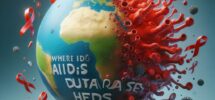Imagine a clear blue sky in the late 1970s. The world was dancing under the disco ball of carefree nights, humming to the tunes of freedom and change. That storm had a name: AIDS.

Where Did AIDS Come From?
To understand the chaos of the 1980s, we must first ask: Where did AIDS come from?
Scientists trace the origin of AIDS to Central Africa. A virus called HIV (Human Immunodeficiency Virus), believed to have jumped from chimpanzees to humans through a process called zoonosis, quietly spread across populations. This transfer likely happened as early as the 1920s, but the virus remained a ghost — present, but unnoticed. It wasn’t until the early 1980s, when strange illnesses began surfacing in the United States, that the world started to feel the chill.
So, where did AIDS come from? It came not just from a biological mutation, but from a world unprepared to see beyond borders, blood types, and biases. It emerged from shadows — biological, political, and social.
The First Thunderclaps: Early 1980s
The medical community was baffled. The media soon dubbed it “the gay plague,” a label drenched in stigma and fear.
The truth was broader and deadlier. AIDS did not care about gender, sexuality, or race. Intravenous drug users, hemophiliacs, and later, heterosexual populations began to fall ill. But by then, the storm had already turned into a hurricane.
The Cultural Fallout: Fear, Blame, and Silence
The 1980s were not just about medical confusion; they were about societal hysteria. People avoided touching, hugging, or even sharing utensils with those infected. Patients were fired from jobs, evicted from homes, and in many cases, left to die alone.
Hollywood stars like Rock Hudson, who publicly battled AIDS in 1985, brought the disease into the spotlight. But still, silence hung thick. Governments were slow, funding was scarce, and public empathy was patchy.
Meanwhile, activists — from ACT UP to grassroots organizers — became the real first responders. With placards, protests, and passion, they screamed into the storm.
Where Did AIDS Come From — As a Cultural Tsunami?
AIDS didn’t just come from a virus; it came from a perfect storm of neglect, ignorance, and shame. It exposed the cracks in public health systems, the cruelty of societal prejudice, and the cost of silence.
Musicians, writers, and filmmakers began to reflect the trauma. AIDS was no longer a medical condition — it was a mirror held up to society.

The Dawn After Darkness
By the late 1980s, research intensified. The question “Where did AIDS come from” remained central to both scientific inquiry and public conversation.
From Africa’s rainforests to America’s city streets, the journey of AIDS was now a global narrative. The 1980s had borne witness to pain and awakening. And though the decade ended, the battle was just beginning.
So, where did AIDS come from? From a viral mutation, yes — but also from the corners of a world that wasn’t ready to look, listen, or love without judgment. The 1980s taught us that disease doesn’t just test the body — it tests our humanity. And in the story of AIDS, we found not just a medical history, but a cultural reckoning.


